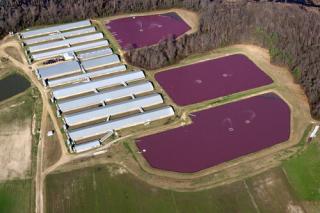Blog
Why Animal Sludge is a Critical Issue for Our Environment and Health
Buckle up. This is about to get gross. If you have hand sanitizer and a clothespin for your nose, that might help.


By Paul Koenig
Buckle up. This is about to get gross. If you have hand sanitizer and a clothespin for your nose, that might help.
Animal sludge (the excrement from protein farms) has been found in our water table, food supply, and even in the air we breathe.
In other words, poop has been found in the water you drink and the meat in your burger.
If it couldn’t get any worse, animal sludge has tormented farm communities, specifically on the east coast, where animal waste is sprayed next to homes less than a 10 minute walk away. The smell is not only intolerable, but the air also exacerbates upper respiratory conditions, spreads fecal particulate in the air, and more. One local said, “It smells like a decomposing body.”
You’d think that fecal matter potentially contaminating your food and water would be the top complaints from the local communities surrounding animal farms.
Do we need to say more?
Sludge waste is a serious problem in the protein industry. Not only are waste lagoons an eyesore (be careful if you look at one, you might get a stye in your eye or worse pink eye), but they pose a huge risk for our environment and our health. By educating you on these risks, we hope to inspire you to help us make a change in an industry that desperately needs innovation.
Animal Sludge Smells Like a Decomposing Body
Most of us like to think that our produce is fresh and pure, arriving on the grocer’s shelf almost as if by magic. “Farm-to-table” has taken on a folksy hue without disclosing how agribusiness and animals have aggressively altered or contaminated our food, water, and air supply.
If you’ve ever driven on the I-5 in California past the Harris Ranch, or through South Carolina hog country, you know how epic the odors are. Savvy road-trippers will roll their windows up miles in advance and crank the recirculated (air from inside the car) AC setting until well past the offending farms.
Residents in communities up to fifteen miles away develop unique ways to combat the toxic fumes which overwhelm their dwellings multiple times per day, some planting vast herb or flower gardens, others keeping large amounts of sage and incense on hand. Their only real salvation is a change in the wind, which is temporary, but it doesn’t lessen the risk to their health the odors pose including airborne pathogens such as salmonella. Farmers and their neighbors face exposure to PM10 (particulate matter 10 micrometers in diameter) which may produce diseases that impact the upper and proximal airways.
As we know with COVID, pathogens can be transmitted via air, and if animal sludge is full of pathogens, then this smell can cause a huge unintended health risk to anyone breathing in the foul odor.
If things couldn’t get any worse, this stench also lowers property values, prevents people from moving into local neighborhoods, all of which indirectly impacts the local economy. Property values in neighboring communities have been plummeting according to the National Association of Local Boards of Health, “The most certain fact regarding CAFOs and property values is that the closer a property is to a CAFO, the more likely it will be that the value of the property will drop.”
Related: Understanding Concentrated Animal Feeding Operations and Their Impact on Communities
Animal Sludge Brings Fly Swarms and Other Insect Infestations
In the North Carolina Smithfield Farms case, “Neighbors say for decades they’ve tolerated clouds of flies drawn to open-air waste cesspools, smells so intense they cling to upholstered furniture and buzzards feasting on the flesh of dead hogs stacked near their homes.”
Without proper treatment, animal waste, especially in large quantities, can be host to many unwanted lifeforms. Flies are standard on untended feces. Maggots often move in to finish off anything they can find while intestinal worms can also thrive in the pits most mega-farms employ.
But it’s the smaller lifeforms that thrive—microbial growth and contamination are of greatest concern.
Viruses, Bacteria, and Pathogens are Sprayed Onto Fields, Using Millions of Gallons of Water and Gasoline
“On a large double barn CAFO (concentrated animal feeding operation) of 13,000 growing spaces the quantity of miles driven by a tractor to spray the effluent-waste is equivalent to driving from Omaha, Nebraska to Sydney, Australia if you could do that directly,” explains Paul. “It’s a giant expenditure that can be completely removed with Viroment’s technology.”
As a result the expense and energy, the ‘manure water’ as farmers like to call it, is a mix of viruses, bacteria, and other pathogens that are sprayed without knowing the exact strength of the manure nutrients.
If the manure does not bathe in the hot sun to appropriately kill the pathogens, then we risk contaminating the environment later down the line. While spraying is regulated state by state and there are numerous steps required to keep distribution even, like, time in the sun, turning the soil, spraying less in lower elevations, there are many more documented hazards from factory-farming animal protein.
Animal Sludge is an Enormous Producer of Greenhouse Gases
Livestock (including poultry) accounts for about 14.5 percent of anthropogenic greenhouse gas emissions. “On CAFO’s, you have these manure pits which are just massive festering, stench-piles emitting carbon-gases which is contributing to the planet’s overall greenhouse gas problem,” Paul describes.
The greenhouse gases emitted from manure systems include, “Methane and nitrous oxide, which form as the manure slowly decomposes in pits or lagoons, contributing to the greater carbon footprint of animal production,” according to IPELC.
Related: Carbon Footprint, Life Cycle Analysis, and The Pork Industry
“Yet, this carbon footprint can be drastically reduced with proper management and utilization of animal manure, such as Viroment’s technology which separates useful fertilizers from reusable water at the source,” says Paul.
Drastically reducing the impact of greenhouse gases from animal production on our ozone layer would make the meat industry not only more sustainable but improve global air quality and reduce the potential escalation of climate change as a whole.
Animal Sludge Has Vast Impact on Water Tables and Marine Environments
Many reports have concluded that nitrate runoff is creating outbreaks of algae which are killing fish and destroying ecosystems that local people rely on to survive. Shockingly in the last ten years, reports of algae bloom outbreaks in North America have risen exponentially with no end in sight.
Algae blooms not only suffocate and kill the existing marine wildlife but also pose a huge danger to human health. Many types of algae blooms emit cyanotoxins that have a range of various negative effects on humans. One report listed the various health effects of cyanotoxins released from algae blooms.
This impacts generations of humans and all living things. It is interruptible but the conditions are dire, ”People just can’t ignore this,” said Naeema Muhammad, a co-director and community organizer at the North Carolina Environmental Justice Network. “The air stinks, the water is contaminated and property values are depleted.”
The Viroment Solution
Viroment is on a mission to replace our current filthy farming system with a clean, profitable solution. Over 100,000 square miles of waste are stored this way in Iowa alone. Each Viroment hog barn removes one square mile (484 football fields) of hog manure and improves management!
Each installation (barn) produces $4M in protein products annually, once in operation. Each barn creates 42 farm-to-table jobs long-term, many more during construction. As mentioned, each barn removes (eliminates, destroys, negates, obliterates at the source) a square mile of open effluence storage, AND, the fuel and labor to subsequently spray all that crap onto the ground.
It’s okay if you’re vomiting in a bucket by now. We told you this would be gross. Fortunately, you made it to the good news and the better news. Not only is there a solution, but you can also join in bringing that solution to the market by joining Viroment’s equity crowdfunding campaign where you can read all the details about the annual yield on their debt note.
COMING SOON! The Top Reasons Why You Should Invest With Viroment
“Sure, we’re open to investors who understand the business, but we’re also interested in connecting with urban foodies who want a clean piece of meat on their plate. We’re interested in working with environmental groups who’ve been standing against water pollution. We believe with enough information anyone and everyone will want this new standard in protein production. This is a movement we’re starting and we want to take it to the world with your help,” Paul completes.
